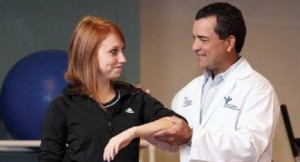Recovering from Tennis Elbow
 Misleading as the name may be, tennis players are not the only people to suffer from tennis elbow. The condition is most often caused by overuse of the forearm muscles using a repeated twisting motion, and these movements are common to various jobs such as carpentry or plumbing, and many daily activities such as yard work and lifting objects. Racquet sports, swimming, and throwing sports (such as baseball) can also lead to tennis elbow.
Misleading as the name may be, tennis players are not the only people to suffer from tennis elbow. The condition is most often caused by overuse of the forearm muscles using a repeated twisting motion, and these movements are common to various jobs such as carpentry or plumbing, and many daily activities such as yard work and lifting objects. Racquet sports, swimming, and throwing sports (such as baseball) can also lead to tennis elbow.
Recovery
Most cases of tennis elbow respond to rest, ice, rehab exercises, pain medicine, and counterforce braces. This injury does take from 6 months to 12 months to heal. Patience helps.
Physical rehab combined with tendon rest is the main tennis elbow treatment. Over the first months of recovery from tennis elbow, those who are diagnosed with the condition should begin rehabilitation for their injury. This rehab can include exercise treatments to decrease pain and increase range-of motion, and wearing a special “counterforce” brace to help spread pressure throughout the arm.
A physical therapy program not only helps heal injured tendons and muscles but also helps prevent further injury. If you’re an athlete, you may also want to work with an expert sports performance specialist before returning to the sport to see whether you need to change how you do an activity or what equipment you use. If you feel that certain activities at your job are causing elbow pain or soreness, talk to an occupational therapist who can help you operate better with your workplace, by modifying your workspace, tools, or job process.
Prevention
If you want to prevent a recurrence of tennis elbow there are some simple lifestyle adjustments you can make to better preserve your joint:
- Use the correct techniques and movements during activities.
- Use equipment appropriate for your ability, body size, and body strength.
- Do not overuse your arm with repeated movements that can injure your tendon.
For example, alternate hands during activities, if possible. - Strengthen the muscles of your arm, shoulder, and upper back to help take stress off of your elbow.
- Wear a “counterforce” brace during activities that require grasping or twisting arm movements.
A counterforce brace is a strap worn around your forearm just below your elbow. This brace may distribute pressure from muscle use throughout the arm, easing pressure on the tendon. A counterforce brace is not a substitute for rehab exercises or an excuse to continue “overuse” activities. - Consider taking lessons to learn the proper technique for sports.
Sports such as tennis and golf require grasping and twisting motions in the arm. Have a sports trainer or a person who is familiar with sports equipment check yours to make sure it suits your level of ability, body size, and body strength. - Train yourself to use techniques that won’t stress your elbow.
In daily routines or hobbies, look for activities that use repeated arm movements that strain your fingers, wrist, or forearm, such as in gardening, cooking, or playing musical instruments. For example, when you lift objects, lift with the palm of your hand facing upwards.
+ Read about our Tennis Sports Performance Program.
+ Find an Occupational Therapist near you.
